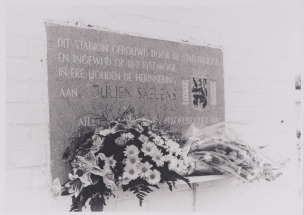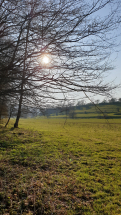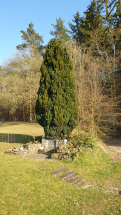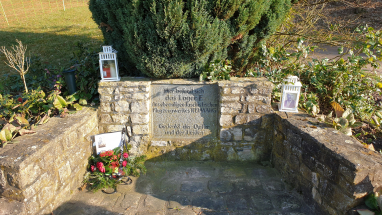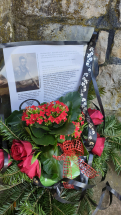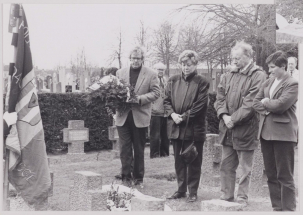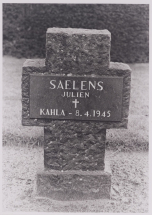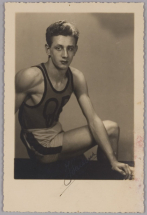It’s April 7, 1945, some days before the liberation…
Returning from work, the exhausted and hungry forced laborers of Lager E queue in long queues before the kitchen. Survivors report unanimously that this situation was always very chaotic. Everyone was hungry and wanted to have their meager ration quickly. One of the forced laborers in the queue is 24-year-old Julien Saelens from the Belgian city of Bruges.
Julien, born August 20, 1920 in Bruges , was well known and popular among his Belgian comrades. As a trained furniture maker, he had joined the resistance as a young man, was betrayed, arrested on May 11, 1944 and deported to Kahla.
He began his sports career as an athlete in 1936 at the sports club Olympic Brugge. Two years later he became Belgian champion in the 100m and 200m run. From now on he continuously improved his best times in every further competition.
Much has been written and said about the death of Julien Saelens, with statements and sources often contradicting each other. In our archive there is a very important, unique document. It is the eyewitness account of a Belgian comrade of Julien Saelens, which states: “After returning to Lager E, we all arrived at the kitchen building to receive our beet soup. Handing out the soup happened through a window. This often took a long time and the starved comrades were restless and pushed each other, under the eyes of the nervous SS. Julien knew it would take hours and decided to enter the kitchen through another entrance to receive his portion. However, this entrance was guarded by an SS man who brutally pushed back Saelens. Julien stumbled, got up again, with his back to the security guard, and called him “Smeerlap” (pig dog). The security guard then pulled his weapon and shot Saelens in the back, the bullet hitting the left kidney and exiting in front. A nearby Italian forced laborer is also hit on the thigh. This happened within 30 seconds. The crowd flees in panic in all directions as many believe it continues to be shot.
Both Saelens and the Italian fall to the ground, get no help from the security guard. Two comrades of Saelens, Jacques Daems and Albert Lannoy, take him to the hospital, in the camp. Unfortunately, the Belgian doctor practicing there can do nothing more for him. Julien Saelens is still in good health and fighting for his life. “My belly, my belly,” he shouts. The doctor is powerless and can only administer a painkiller that does not help him. His comrades ask him what they can do, if he needs something… He replies: “Take my wallet, my watch and bring it to my mother!”. Albert Lannoy takes the wallet, the watch and the photos of Julien Saelens’ fiancée. He promises Julien to bring everything to his family. To which Saelens replies: “Tell them home that they murdered me. I am sorry that this happened so close to liberation. Tell them that I always thought of them and that my last thoughts were with them.”
The pain returns more and more, he faints and Julien is taken to a shack where the dead are stored. It is now 7 p.m. Ten minutes later he wakes up again and says: “Now it’s over, I’m dying, goodbye friends, long live Belgium and thank you…”. Julien Saelens is dead. At 8 p.m., his body is wrapped in a blanket and taken to a small field nearby, above the camp. Here he is placed in a wooden box, his friends close his eyes and mouth and place a paternoster in his hands. Two days later he is buried, without worship or farewell.
The Belgian military mission, which operated after 1945 and whose task it was to find deceased Belgian countrymen, will soon find the dead near the camp. As early as 1947, the small cemetery, above Lager E, was discovered. The dead, who were buried there, are exhumed and transferred to Berlin-Heiligensee. On 26 November 1952, the city of Bruges granted permission to put Julien Saelens in the municipal cemetery as his final resting place. On the basis of our archives, however, he was exhumed in Berlin in 1959 and transferred to Belgium. On 6 February 1960 he was exhumed again and buried in the honor garden in the city of Bruges. In addition to Julien Saelens, two other Belgians, Henri Callaert and Henri Van Caillie, were also transferred, who also died in Kahla.
In August 1957, the “Julien Saelens” stadium was built in Bruges in honor of the talented young athlete who died far too early.
On 8 May 1967, a commemorative race for the murdered Belgian athlete Julien Saelens was held for the first time. This commemorative run would become an integral part of the annual commemorations in May. Athletes from Bruges also took part.
Our association is in close contact with the family of Julien Saelens.
Personal words of his nephew to his uncle Julien Saelens, 2020
Julien, Uncle Julien,
I didn’t know you. I wasn’t even three years old when you were murdered.
Everything I know about you comes from “hear and say”.
Your family was so proud of you. In Bruges you were called the “fast runner”. So many memorabilia of your sporting achievements stood on a place of honor in the parents’ house. Your mother, my patentee, respected her very much. Unfortunately, your father passed away very quickly after you. I never knew him either.
What I still know about you is that my father Albert and you were best friends. You were the two youngest in the family of six children. You played together all the time. Your death took my father with you very much. He always carried a picture of you with him. You were and remained his best friend.
My father hoped to see you again all these years. Is it possible that two of you, in heaven, are reunited as best friends?
When this war is over… When all the wars are over… We continue to dream of peace.
Chris Saelens, 78 Jahre
